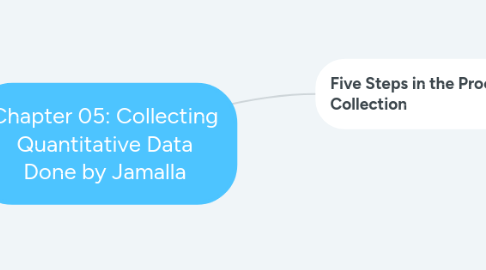
1. Five Steps in the Process of Data Collection
1.1. Determining participants to study
1.1.1. Identify Your Unit (level) of Analysis
1.1.1.1. One for the dependent variable
1.1.1.2. One for the independent variable
1.1.2. Specify the Population and Sample
1.1.2.1. Population
1.1.2.1.1. Example: All teachers in high schools in one city
1.1.2.2. Sample
1.1.2.2.1. Example: All high school biology teachers
1.1.2.3. How to sample?
1.1.2.3.1. Probability sampling
1.1.2.3.2. Nonprobability
1.1.2.4. Sample Size
1.1.2.4.1. Larger the size, the less the potential error
1.1.2.4.2. Sampling error
1.1.2.4.3. Sample size formula
1.2. Obtaining permissions needed
1.2.1. Types of Permissions
1.2.1.1. Institutions or organizations (e.g., school district)
1.2.1.2. Specific sites (e.g., secondary school)
1.2.1.3. Individual participants
1.2.1.4. Parents of participants who are not considered adults
1.2.1.5. Campus approval (e.g., university or college) and Institutional Review Board (I R B)
1.2.2. Review Board Approval
1.2.2.1. Process
1.2.2.1.1. finding out about the review process
1.2.2.1.2. what information the review board needs
1.2.2.1.3. form for participants to sign
1.2.2.1.4. submit a description of your proposed study
1.3. Considering what types of information to collect
1.3.1. Flow of Activitis
1.3.1.1. Identify the variables
1.3.1.2. define the variables
1.3.1.2.1. Identify how to measure
1.3.1.2.2. Cite other authors who have defined
1.3.1.2.3. how to define and measure the variable
1.3.1.3. locate data
1.3.1.4. collect data
1.4. Locating and selecting instruments
1.4.1. Instrument
1.4.1.1. a tool for measuring, observing, or documenting quantitative data
1.4.1.2. Locate or Develop an Instrument
1.4.1.2.1. Develop it yourself
1.4.1.2.2. Modify an instrument: locate an existing instrument, obtain permission to change it, and make changes in it to fit your requirements
1.4.1.2.3. Locate one to use in its entirety
1.4.1.3. Steps in Developing or Constructing an Instrument
1.4.1.3.1. Phase I: Planning
1.4.1.3.2. Phase II: Construction
1.4.1.3.3. Phase III: Quantitative Evaluation
1.4.1.3.4. Phase IV: Validation
1.4.1.4. Search for an Instrument
1.4.1.4.1. published journal articles
1.4.1.4.2. E R I C search
1.4.1.4.3. Tests in Print
1.4.1.4.4. Mental Measurements Yearbook
1.4.1.5. Criteria for Choosing a Good Instrument
1.4.1.5.1. General
1.4.1.5.2. Reliability
1.4.1.5.3. Validity
1.4.1.5.4. Adequate Scales of Measurement Used?
1.4.2. Types of data and Measures
1.4.2.1. Measures of individual performance
1.4.2.1.1. assess an individual’s ability to perform on
1.4.2.2. Measures of individual attitude
1.4.2.2.1. measures feelings toward educational topics
1.4.2.3. Observations of individual behavior
1.4.2.3.1. selecting instrument to record a behavior
1.4.2.3.2. observing individuals
1.4.2.3.3. checking points
1.4.2.4. Factual information (example: survey)
1.4.2.4.1. consist of numeric, individual data available in public records. Examples ->
1.4.2.4.2. Privacy regulations may apply
1.4.3. Digital Methods of Data Collection
1.4.3.1. Use of websites and the Internet
1.4.3.1.1. surveys
1.4.3.1.2. interviews
1.4.3.1.3. social media (e.g., Facebook, Twitter)
1.4.3.1.4. existing databases
1.4.4. How to Decide What Types to Choose
1.4.4.1. What am I trying to learn?
1.4.4.2. What is realistic to collect?
1.4.4.3. What are the advantages and disadvantages?
1.5. Administering the data collection
1.5.1. Standardization
1.5.1.1. Develop standard written procedures for administering an instrument
1.5.1.2. Train researchers to collect observational data
1.5.1.3. Obtain permission to collect and use public documents
1.5.2. Ethical Issues
1.5.2.1. Respect individuals and sites during data gathering (ethics)
1.5.2.2. Obtain permissions
1.5.2.3. Protect anonymity by assigning numbers to instruments
1.5.2.4. Respect those who do not want to participated
1.5.2.5. Observations can be disruptive
